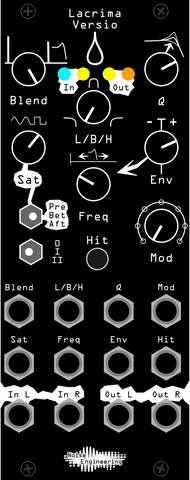Lacrima Versio Deep Dive
Last month, we released the Lacrima Versio, which we’re calling the devil’s autowah. It started out as an alternate firmware only, but due to popular demand, it’s now its own module, too. It’s shipping now, and you can order yours today! In this post, we’ll dive into Lacrima’s history, what an autowah actually is, take a listen to some patches, and make as many wah puns as we can.

Wah back when...Lacrima history
In 2019, we launched “Distortion of the Month,” a series of analog distortions that remain near and dear to our hearts. We stopped at 5 modules but there were always more that we wanted to do. Lacrima started its life as an analog wah that Kris desperately wanted to bring to Eurorack. We discussed features and started a schematic, but as work progressed on the Versio platform, we realized that we could do an even cooler, more fully featured version there. What those features would be, though, took some time to sort through. In the end, we fused a few somewhat independent ideas to make Lacrima. We eventually agreed on the wah + distortion we had originally planned in analog combined with a virtual analog take on the Mu-Tron 3. We merged these into an envelope follower + distortion + SVF filter structure and as we developed it further we added some features from our analog distortion Viol Ruina (which has a similar structure) to round it off. Lacrima Versio is a firmware that surprised even us when it was done. Stephen and Kris both are head over heels for this one (Kris even says it is her favorite in the Versio lineup so far!). If you love dynamics, give Lacrima Versio a try.
Waht is a wah?
A wah is the best type of effect. Why, you may ask? Because it’s onomatopoeic: it’s named after the sound it makes. If you ask me, we should do this for all music equipment, but the last time I called an oscillator a “bzzzzz” I got some strange looks. Oh well.
Not only does the wah have a great name, it’s a super fun type of effect, too. Wahs started as foot-controlled pedals for guitarists. They’re a simple filter that changes frequency depending on the position of the pedal. This gives the pedal its name: the filter adds a vocal effect when modulated, so it can sort of sound like the pedal is talking. It’s an effect you’ve definitely heard on a record or two.
Taken a step further, an autowah adds an envelope follower to the effect: the envelope controls the filter, so all the wah-ing is taken care of automatically. Of course, we added some of our own tweaks, but the core autowah concept is what Lacrima is built around.
Wah (GOOD GOD!) What is it good for?
We’ve all heard wah pedals used on guitars, but like many effects originally designed for guitar, they can be used to great effect on synths, too. We decided that we wanted to extend the traditional functionality of a wah to make it work even better for Eurorack patches, so the filter type can be morphed between a lowpass, a bandpass, and a highpass filter, all with adjustable resonance. Since the autowah reacts to dynamics, Lacrima will be most noticeable when used to process signals with a lot of dynamic content. In this first patch, we’ve created a simple sequence vaguely emulating a guitar lead, with some volume modulation per step, too. Using a bandpass filter with high resonance and just a touch of distortion, we really add a lot of flare to our sequence.

Wah: they’re not just for wah-ing anymore
That last patch was an interesting example of taking the traditional electric guitar sound and creating a patch that follows some of the same characteristics. However, this being modular, there are a lot of other things we can do that break away from traditional sounds. Here, a saw stab from LIP goes into Lacrima, and with a bunch of distortion on a lowpass setting we get an instant acid bassline.

Kick it up a notch: wah your percussion
We’ve used our wah for a couple of melodic patches, but it adds some wonderful flare to percussion, too. Here, we have a stereo mix out of some drum voices being processed by Lacrima: using Blend to create a careful wet/dry balance lets us blend in some heavily processed effects without losing the transient punch of the drums.

Don’t cry: Lacrima is now available. buy the module or try it for free
If you own a Versio already, you can try out the firmware completely free at our Customer Portal. However, so many of you asked for a full Lacrima release that you can now buy it as its own module, too! It’s shipping now, so order yours today.





